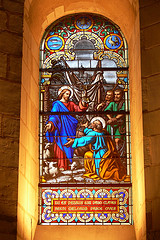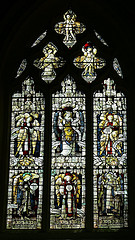Selles-sur-Cher
Submitted by walwyn
This window of St. Peter receiving the keys of heaven, in the church of Notre Dame la Blanche, Selles-sur-Cher, is by Claudius Lavergne. The window is dated 1889 which is two years after Claudius Lavergne's death.

This window of St. Peter receiving the keys of heaven, in the church of Notre Dame la Blanche, Selles-sur-Cher, is by Claudius Lavergne. The window is dated 1889 which is two years after Claudius Lavergne's death.
 Hudson, Shrigley and Co were originally church decorators in Lancaster. In about 1871 they employed, Arthur Hunt from Hertfordshire, who had trained as a stained glass maker with Heaton, Butler and Bayne, as the company manager. Hunt had a good business sense and within 8 years had taken over control of the company, employing talented artist like Carl Almquist and Edward Jewitt. Carl Almquist became the chief designer for the firm in 1873 and from 1879 was working mainly from their newly acquired London Studio. The company also made art tiles and developed a style of figurative stained glass work that was inspired by the Renaissance rather than the Gothic
Hudson, Shrigley and Co were originally church decorators in Lancaster. In about 1871 they employed, Arthur Hunt from Hertfordshire, who had trained as a stained glass maker with Heaton, Butler and Bayne, as the company manager. Hunt had a good business sense and within 8 years had taken over control of the company, employing talented artist like Carl Almquist and Edward Jewitt. Carl Almquist became the chief designer for the firm in 1873 and from 1879 was working mainly from their newly acquired London Studio. The company also made art tiles and developed a style of figurative stained glass work that was inspired by the Renaissance rather than the Gothic
Cartoons of St Elizabeth and St Anne by Ford Madox Brown.

The story of stained glass in England is one of both loss and renewal. The medieval and Renaissance centuries had produced a luminous synthesis of theology, craft, and architecture, an art that translated divine light into visible doctrine. Yet, with the Reformation and subsequent waves of iconoclasm, much of this splendour was extinguished. For nearly three hundred years, the craft languished, its techniques fragmented and its spiritual vocabulary forgotten